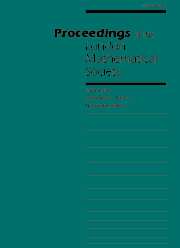No CrossRef data available.
Article contents
On Polar Duality, Lagrange and Legendre Singularities and Stereographic Projection to Quadrics
Published online by Cambridge University Press: 23 October 2003
Abstract
We establish the correspondence between Euclidean differential geometry of submanifolds in $\mathbb{R}^n$ and projective differential geometry of submanifolds in $\mathbb{R}^{n +1 }$ under stereographic projection to quadrics of revolution (and to a more general class of quadrics called quasi-revolution quadrics). V. D. Sedykh found a relation between Lagrangian and Legendrian singularities by stereographic projection to a sphere in Euclidean space. We generalise Sedykh's results in several directions, for instance:
(1) such a relation holds for any stereographic projection of a hyperplane to a quasi-revolution quadric in $\mathbb{R}^n \times \mathbb{R}$, where here $\mathbb{R}^n$ denotes Euclidean space;
(2) when the quadric is a paraboloid the relation between Lagrangian and Legendrian singularities is the most natural one, and the calculations, formulas and proofs are simpler;
(3) using the classical theory of poles, polars and polar duality, we construct the natural isomorphism between the front of the Lagrange submanifold of the normal map (considered as a subvariety in $J^0(\mathbb{R}^n) = \mathbb{R}^n \times \mathbb{R}$) and the front of the Legendre submanifold of the tangential map (considered as a subvariety in the space $(\mathbb{R}^{n + 1})^\vee$ of affine n-dimensional subspaces in $\mathbb{R}^{n + 1}$).
As a consequence of our results we obtain a formula to calculate the vertices of smooth curves in $\mathbb{R}^n$. Our results may be applied to calculate and study umbilic points of surfaces in $\mathbb{R}^3$, or more generally to study the contact of submanifolds in Euclidean space $\mathbb{R}^n$ with k-spheres, for $k = 1,\ldots,n - 1$, in terms of the contact of submanifolds in $\mathbb{R}^{n + 1}$ with $(k + 1)$-planes.
We remark that it is possible to obtain additional geometric information when stereographic projection is replaced by an inversion.
Keywords
- Type
- Research Article
- Information
- Proceedings of the London Mathematical Society , Volume 87 , Issue 3 , November 2003 , pp. 701 - 724
- Copyright
- 2003 London Mathematical Society


